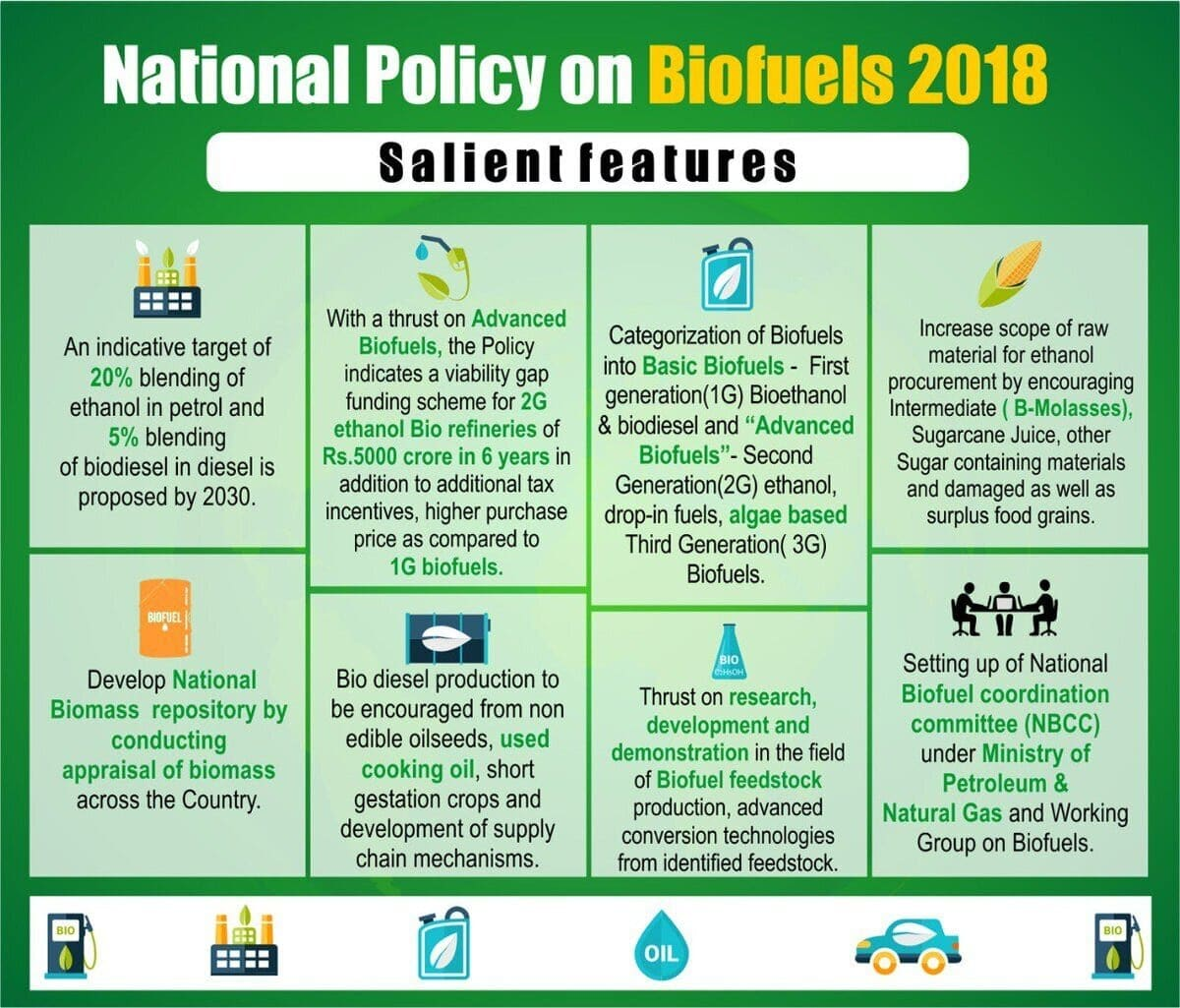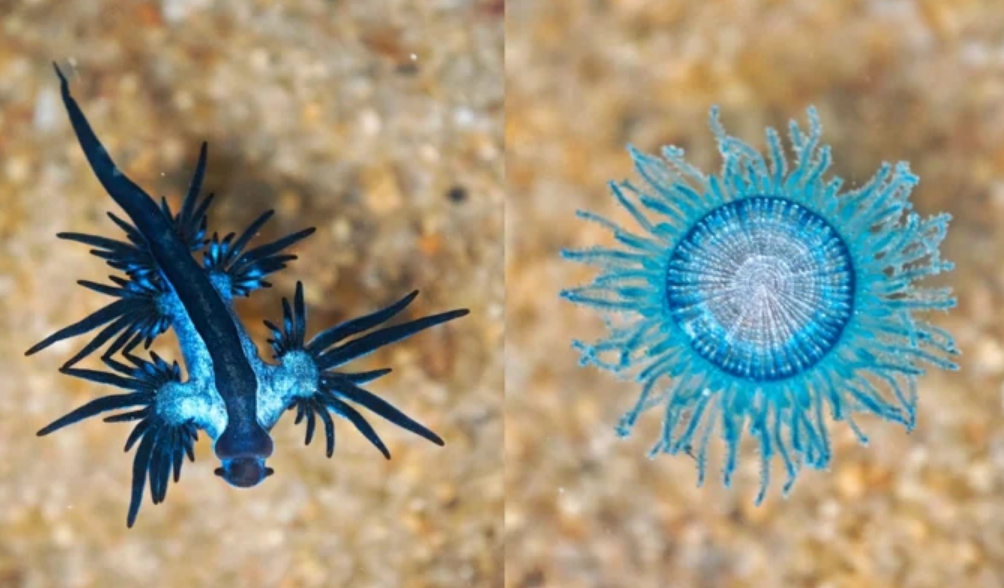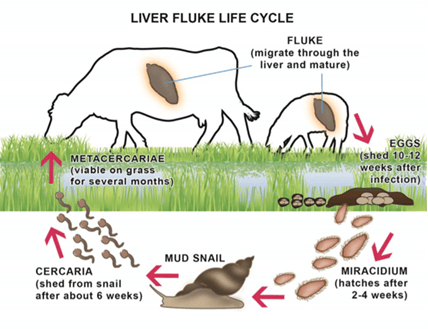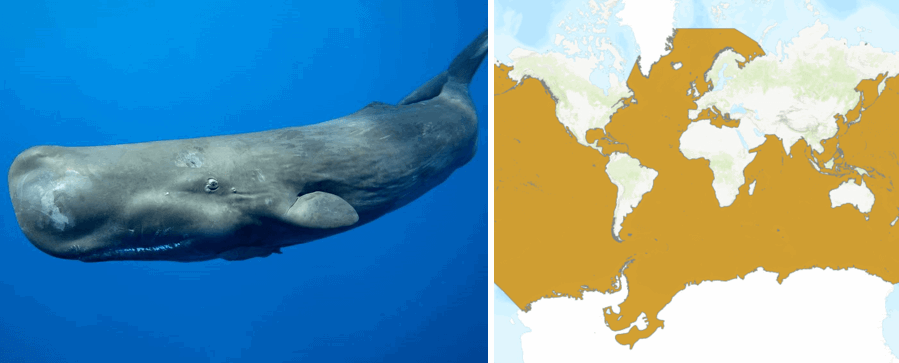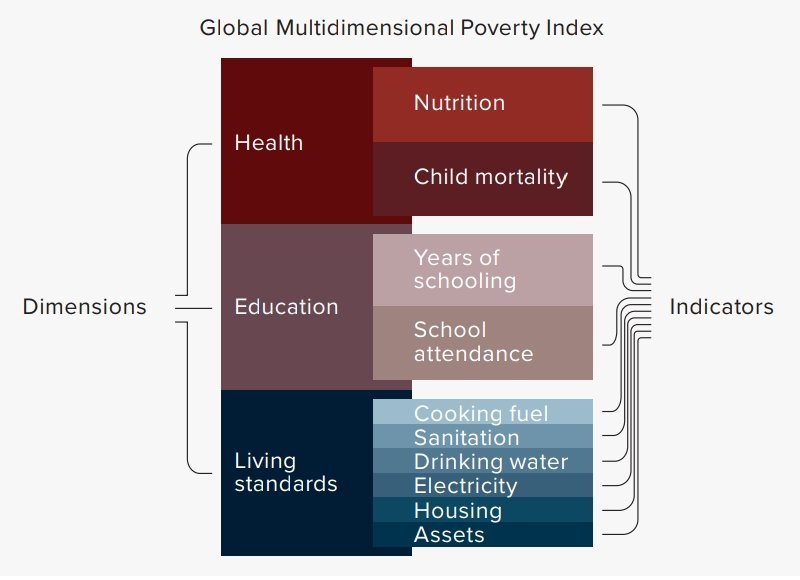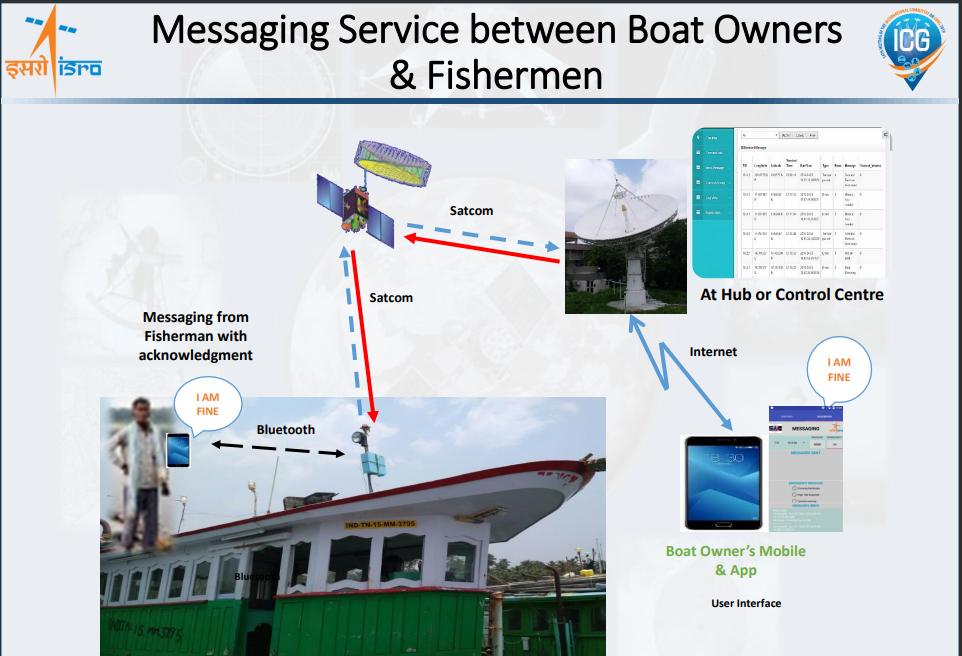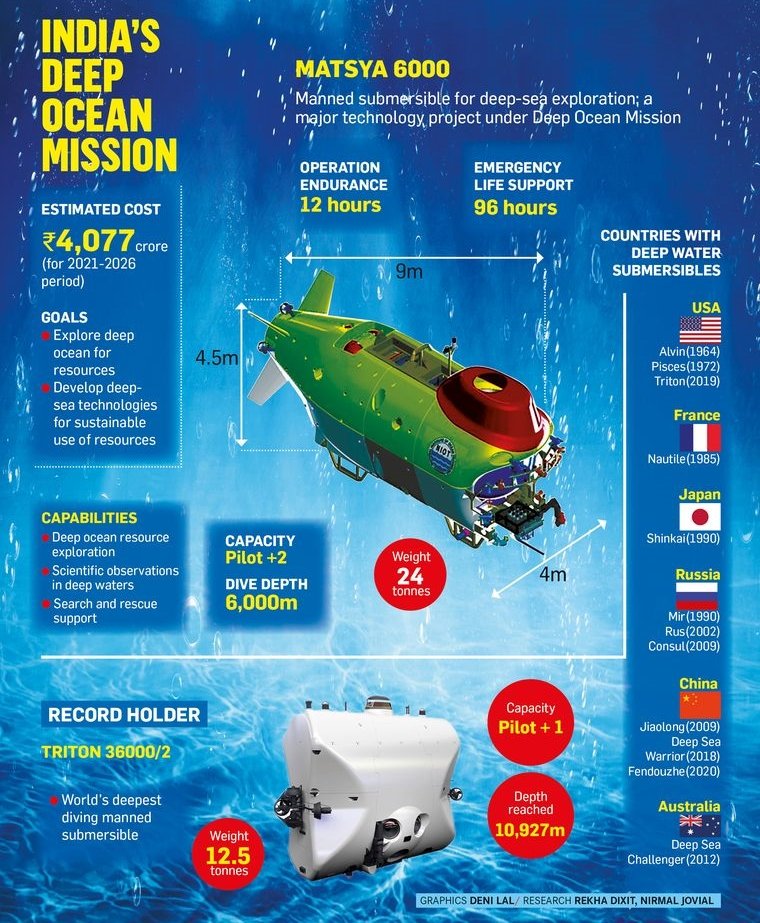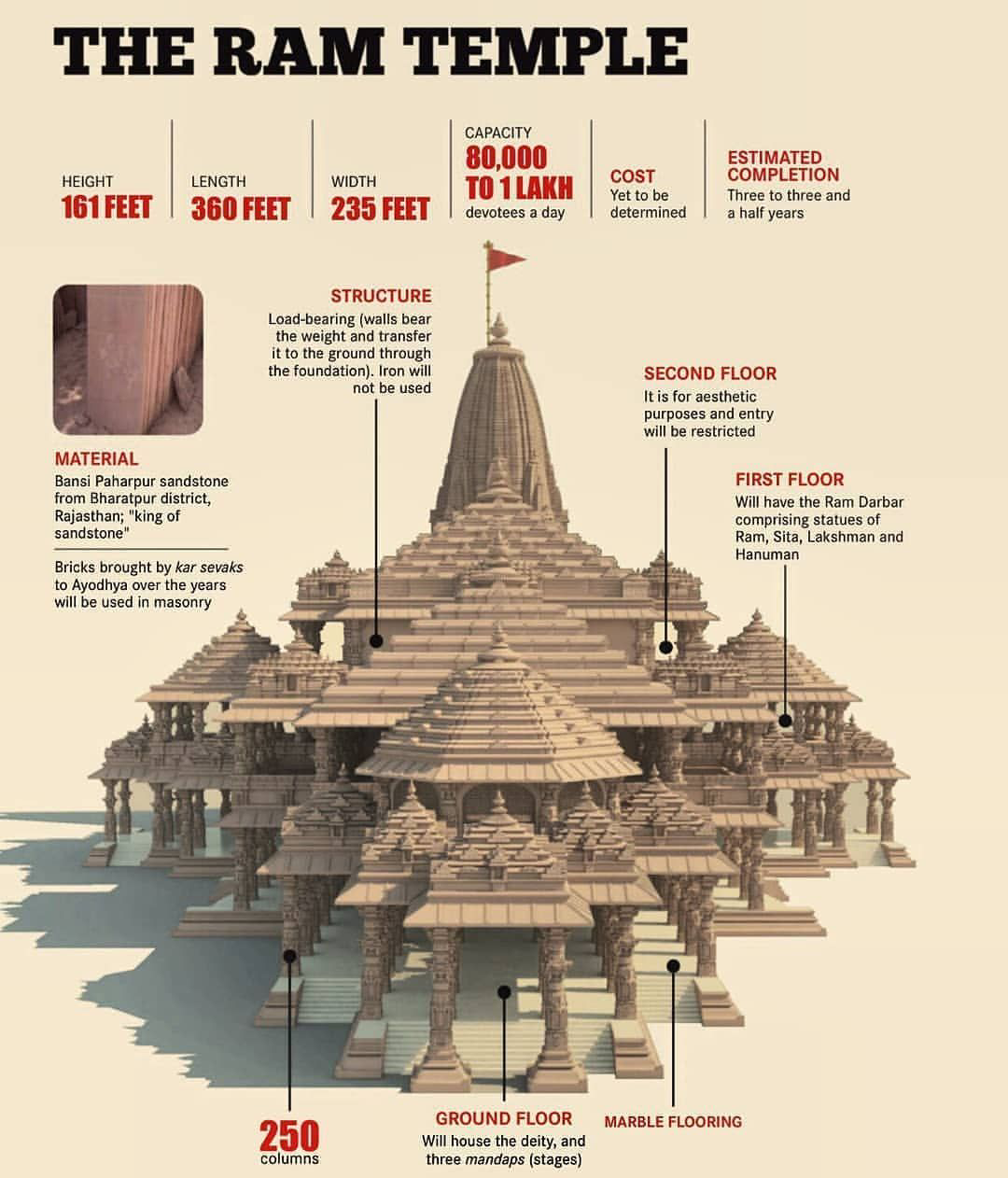
Current Affairs December 22, 2023: Maitri II Station in Antarctica, Black Tiger, EU Pact on Migration and Asylum, Three Criminal Law Bills, Compressed Biogas Blending Obligations (CBO), Blue Sea Dragon
Subscribers of "Current Affairs" course can Download Daily Current Affairs in PDF/DOC
Subscribe to Never Miss an Important Update! Assured Discounts on New Products!
Must Join PMF IAS Telegram Channel & PMF IAS History Telegram Channel
{GS2 – IR – Antarctica} Maitri II Station in Antarctica
- Context (PIB): GoI intends to operationalise a new research station in East Antarctica near the existing research base Maitri. The research station is expected to be complete by January 2029.
India’s Research Stations in Antarctica
- The first permanent research station was “Dakshin Gangotri” in 1983 (now abandoned).
- Maitri: India’s second permanent research station operational since 1988. Lake Priyadarshini, a freshwater lake, was built by India around Maitri.
- Bharati: Operational since 2012, it is India’s first committed research facility located 3000 km east of Maitri.
India Antarctica Programme
- It is a scientific research and exploration program under the National Centre for Polar and Ocean Research (NCPOR), Goa.
- It started in 1981 when the 1st Indian expedition to Antarctica was made.
India Antarctica Act 2022
- The Act seeks to give effect to:
- Antarctica Treaty.
- Protocol on Environmental Protection to the Antarctica Treaty.
- Convention on the Conservation of Antarctica Marine Living Resources.
- Applicability: To any person, vessel, or aircraft that is a part of an Indian expedition to Antarctica under a permit issued under the Act.
- The Act provides for a Central Committee on Antarctica Governance and Environmental Protection.
- The Central Government would establish it under the administrative control of the Ministry of Earth Sciences (MoES).
- It would ensure compliance with international laws to protect the Antarctica environment.
- The Act provides for penalties for contravention of the Act’s provisions. E.g., 20-year imprisonment for conducting a nuclear explosion in Antarctica.
- It provides for the Antarctica Fund for the welfare of research work and protection of Antarctica.
- It also provides for designated courts and inspection teams to carry out inspections in Antarctica, etc.
Activities Prohibited
- Nuclear explosion/disposal of radioactive wastes.
- Introduction of non-sterile soil/any specified substances and products.
- Discharge of garbage, plastic, or substances into the sea, which is harmful to the marine environment.
- Damage, destroy, or remove any historic site or monument.
Permit needed
- An Indian expedition to enter/remain in Antarctica.
- A person, vessel/aircraft registered in India to enter/remain in Antarctica.
- A person/vessel to drill, dredge, excavate for mineral resources, or collect samples of mineral resources.
- Activities that may harm native species.
- Waste disposal by a person, vessel or aircraft in Antarctica.
Antarctica Treaty
- It laid the foundation of a rules-based international order for a continent without a permanent population.
- It remains the only single treaty that governs a whole continent.
- It was signed on 1st December 1959 (entered into force in 1961) in Washington.
- Initially, 12 member parties; currently, it has 54 members. India became a member of this treaty in 1983.
- Headquarters: Buenos Aires, Argentina.
- The treaty declares the continent as the world’s 1st nuclear-weapon-free zone to be preserved for scientific exploration.
Provisions
- Application of the treaty: All areas south of latitude 60°. It excludes the high seas, which come under international law.
- The treaty provides for the use of the continent only for peaceful purposes, including promoting the freedom of scientific research.
- It neutralises territorial sovereignty, limiting any new claim or enlarging the existing claim.
- It forbids all contracting parties from establishing military bases, carrying on military manoeuvres, testing any weapons (including nuclear weapons), or disposing of radioactive wastes in the area.
- Dispute settlement by the International Court of Justice if they cannot be settled by peaceful negotiation or arbitration by the involved parties.
Protocol on Environmental Protection to the Antarctica Treaty
- Also known as Antarctica-Environmental Protocol or the Madrid Protocol, it was signed in 1991 (entered into force in 1998) as part of the Antarctica Treaty System.
- It prohibits mining, requires environmental impact assessments for new activities, and designates the continent as a natural reserve.
Convention on the Conservation of Antarctica Marine Living Resources.
- Established in 1982 as a part of the Antarctica Treaty System.
- Objective: To preserve marine life and environmental integrity in and near the Antarctic region.
Antarctica Region
- It is the world’s southernmost and fifth-largest continent.
- It is divided into 2 parts: East Antarctica (Largest) and West Antarctica.
- Major geographical features: Ross Sea, Weddell Sea.
- Climate: It is the world’s driest, windiest, coldest, and iciest continent.
- Jurisdiction: It is considered a Global Common and does not come under the jurisdiction of any single Nation/Government.
- It does not have any native population.
- Its Continental ice sheet represents about 90% of the world’s ice and 80% of its fresh water.
{GS2 – IR – EU} EU Pact on Migration and Asylum
- Context (IE): European Parliament and EU government representatives agreed on a New Pact on Migration and Asylum. Approval of the European Council and the European Parliament is still due.
Key Features of the New EU Pact
- Pre-entry screening will include examining an asylum seeker’s profile and collecting basic information.
- Individuals with low-success asylum applications may be barred from entering the EU based on perceived security threats.
- Countries need to follow “mandatory solidarity” by accepting a certain number of asylum seekers or paying a contribution for each refused claimant.
- In crises like COVID-19, national authorities can take stricter norms and more extended detention.
- It is in line with the principle of non-refoulement.
|
EU’s Governance Structure

European Council
- It defines the European Union‘s overall political direction and priorities.
- It comprises the heads of state or government of the EU member states, along with the President of the European Council and the President of the European Commission.
- It was formalised as an institution in 2009 upon the entry into force of the Treaty of Lisbon.
- The decisions of its summits are adopted by consensus.
European Parliament
- It is directly elected by EU citizens aged 18 years or older.
- The European Parliament and Council of the European Union form the legislative organ of the EU.
Council of the European Union
- It represents the EU’s member states’ executives (Ministers).
- Ministers have the authority to commit on behalf of their governments to legislation and actions.
European Commission (EC)
- It is an executive body responsible for implementations and general administration.
- The Commission operates as a cabinet government with 27 members.
- There is one member per member state, proposed by member countries and approved by the European Parliament. Asylum seeker v/s Refugee v/s Migrant
- Asylum seeker: An asylum seeker is seeking protection from persecution and serious human rights violations in the country of origin.
- Refugee: Acceptance from the host country turns an asylum seeker into a refugee.
- Migrant: They have a free choice to relocate, not forced by prosecution or such grave factors.
The Global Refugee Forum 2023
|
{GS2 – MoFPI – Initiative} One District One Product Under PMFME Scheme
- Context (PIB | PIB): The Ministry of Food Processing Industries (MoFPI) has approved ODOP for 713 districts in 35 States/UTs under the Pradhan Mantri Formalisation of Micro Food Processing Enterprises (PMFME) Scheme.
Pradhan Mantri Formalisation of Micro Food Processing Enterprises (PMFME) Scheme
- The PMFME scheme is an initiative under Aatma Nirbhar Bharat Abhiyan.
- It is a centrally sponsored scheme implemented by the MoFPI.
- It provides financial, technical and business support for setting up/upgradation of micro food processing enterprises in the country
- Aims:
- to enhance the competitiveness of existing individual micro-enterprises in the unorganised segment of the food processing industry
- to promote formalisation of the sector (special focus on Farmer Producer Organizations and Self-Help Groups engaged in the agri-food processing sector)
- Objectives:
- Build the capacity of micro-enterprises through increased access to credit
- Integration with the organised supply chain by strengthening branding and marketing
- Increased access to common services
- Strengthening of institutions, research & training in the food processing sector
- It primarily adopts the One District One Product (ODOP) approach to reap the benefit of scale in procuring inputs, availing common services, and marketing products.
One District One Product Scheme
- The UP Government launched ODOP, and later adopted by the GoI.
- It is under the Department for Promotion of Industry and Internal Trade (DPIIT), Ministry of Commerce and Industry.
- It is a centrally sponsored scheme shared by the GoI and states in 60:40 contributions.
- It is operationally merged with the ‘Districts as Export Hub’ initiative.
- Aim: To foster balanced regional development across all districts of the country.
- Idea: to select, brand, and promote one product from each district of the country.
- Objectives:
- To help districts reach their full potential
- To foster economic and sociocultural growth
- To create employment opportunities, especially in rural areas
- Under the scheme, states/UTs identify the ODOP product for a district.
{GS2 – MoHA – Laws} Bharatiya Nyaya Sanhita (BNS)
Provisions of Bharatiya Nyaya Sanhita (BNS)
Offences against the Body
- The BNS retains the provisions of IPC that criminalises acts such as murder, abetment of suicide, assault and causing grievous hurt.
Sexual offences against women
- BNS retains provisions of IPC which criminalises acts such as rape, voyeurism, stalking and insulting the modesty of a woman.
- It classifies the victim as a major (18 years), in the case of gang rape, earlier it was 16 years.
- It also criminalises sexual intercourse with a woman by deceitful means or making false promises.
Terrorism
- It was not included in IPC.
- Terrorism includes an act that intends to
- Threaten the unity, integrity, security or economic security of the country
- Strike terror in the people or any section of people in India.
- Punishment for attempting or committing terrorism includes
- Death or life imprisonment and a fine if it results in the death of a person.
- Imprisonment between five years and life and a fine.
Organised crime
- It was not included in IPC.
- A separate category of “petty organised crime” has also been brought in (theft, snatching, cheating, selling off public examination question papers, etc.).
- Attempting or committing an organised crime will be punishable with
- Death or life imprisonment and a fine of Rs 10 lakh if it results in the death of a person.
- Imprisonment between five years and life and a fine of at least five lakh rupees.
|
Mob lynching
- The BNS adds murder or grievous hurt by five or more people on specified grounds as an offence.
- These grounds include race, caste, sex, language, or personal belief.
- The punishment for such murder is life imprisonment or death.
- The SC in 2018 had asked the Centre to consider a separate law for lynching.
|
Fake news
- The BNS introduces a new provision that criminalises publishing false and misleading information.
Damage to public property
- BNS punishes causing damage to public property with a graded fine, which means the fine corresponds to the damage caused.
Suicide attempt
- The BNS criminalises attempts to commit suicide with the intent to compel or restrain any public servant from discharging his official duty.
- This provision could prevent self-immolations and hunger strikes during protests.
Speedy Legal Procedure
- According to the proposed Bill, a charge sheet must be filed within 90 days, and the court can permit another 90 days.
- The probe must be completed in 180 days and sent for trial.
- After trial, judgment will have to be given in 30 days.
- Courts are to finish framing charges within 60 days of receiving the charge sheet.
- Judgment to be mandatorily delivered within 30 days after the conclusion of the hearing.
- Judgment to be mandatorily made available online within seven days of pronouncement.
Deletions by Bharatiya Nyaya Sanhita (BNS)
Unnatural sexual offences
- BNS repeals Section 377 of the IPC, which criminalised homosexuality among other “unnatural” sexual activities.
- The SC in 2018 (Navtej Singh Johar v. Union of India ) declared it unconstitutional only to the extent that it criminalised consensual homosexual relationships.
Adultery
- BNS has omitted the offence of adultery struck down by the SC (Joseph Shine v. Union of India) as unconstitutional in 2018.
Thugs
- BNS has fully omitted this provision.
- This provision is criticised for attaching colonial notions of criminality for certain tribes.
Gender Neutrality
- The offences dealing with the procuration of a girl (for “illicit intercourse”) have been made gender-neutral.
- For adults, the offence of outraging the modesty of women and voyeurism now has gender neutrality, which means that women can also be booked under the law.
Sedition
- The BNS removes the offence of sedition.
- It instead penalises the following:
- Exciting or attempting to excite secession, armed rebellion, or subversive activities,
- Encouraging feelings of separatist activities,
- Endangering the sovereignty or unity and integrity of India.
- These offences may involve exchanging words/signs, electronic communication, financial means, etc.
Medical negligence
- Cases of criminal negligence are handled under IPC 304 A, which pertains to causing death due to negligence.
- GOI is planning to bring an important amendment in the criminal law bill, which aims to exempt doctors from criminal prosecution in cases of death due to medical negligence.
Mandatory death sentence
- IPC prescribed a mandatory death sentence for murder committed by a life-convict.
- In 1983, the SC struck down the provision as unconstitutional as it took away judges’ discretion in awarding a sentence.
- BNS has prescribed a punishment of “death or imprisonment for life, which shall mean the remainder of that person’s natural life.”
Key Issues and Analysis
The minimum age of criminal responsibility is higher than in several other jurisdictions
- It retained the minimum age for criminal responsibility from seven years and extended to 12 years, depending upon the maturity of the accused.
- This contravenes recommendations of international conventions.
- In 2007, a UN Committee recommended that countries set the age of criminal responsibility to above 12 years.
-
Age of criminal responsibility
- It refers to the minimum age at which a child can be prosecuted and punished for an offence.
- The age of criminal responsibility varies across countries:
- Germany: 14 years
- England and Wales: 10 years
- Scotland: 12 years.
The age threshold of the victim (Children) for similar offences
- The BNS defines a child to mean a person below the age of 18. However, in several offences, the age threshold of the victim for offences against children is not 18.
- The threshold of the victim of rape and gang rape is different.
- Kidnapping a child with the intent to steal from a parent applies only to a child under ten years. This implies that the punishment for kidnapping an 11-year-old is the same as that of kidnapping an adult.
- This is inconsistent with the Protection of Children from Sexual Offences (POSCO) Act, 2012, which classifies all individuals below the age of 18 as minors.
- The Standing Committee on Home Affairs (2023) has recommended defining a child as someone below 18.
Duplication of offences with other special laws
- Several offences overlap with special laws. In many cases, both carry different penalties. This leads to
- Multiple regulatory regimes
- Additional compliance costs and
- Possibility of levelling various charges.
| Offences | BNS | Specials Laws |
| Adulteration of food or drink for sale | Yes | The Food Safety and Security Act, 2006. |
| Adulteration of drugs and sale of adulterated drugs | Yes | The Drugs and Cosmetics Act, 1940. |
| Unlawful compulsory labour | Yes | The Bonded Labour System (Abolition) Act, 1976. |
| Abandoning a child
(Parent or guardian abandoning a child below the age of 12) |
Yes | The Juvenile Justice Act, 2015. Biological parents abandoning a child due to circumstances beyond their control are exempt. |
| Rash driving | Yes | The Motor Vehicles Act, 1988. |
Aspects of sedition retained
- The BNS removes sedition as an offence. However, the provision on endangering India’s sovereignty, unity and integrity has retained aspects of sedition.
- New provisions broaden the range of acts that could threaten India’s unity and integrity.
- Terms like ‘subversive activities’ are also not defined.
- SC has limited the application of sedition to acts with the intention or tendency to create public disorder or incite violence.
Existing Definition of Sedition under Section 124A of IPC, 1860
|
Offences against women
- The BNS retains the provisions on rape and sexual harassment.
- It does not consider recommendations of the Justice Verma Committee (2013), such as making the offence of rape gender-neutral and including marital rape as an offence.
- The phrase “sexual intercourse not amounting to the offence of rape” essentially criminalises consensual sexual activity too.
Adultery
- Adultery has been omitted. However, BNS retains the provision that penalises a man for enticing the wife of another man so that she may have intercourse with any person.
Section 377 of the IPC
- This removes rape of men and bestiality as offences. The Standing Committee on Home Affairs (2023) has recommended re-introducing this provision.
Addition of crimes related to organised crime and terrorism
- Acts of terrorism are covered under the Unlawful Activities (Prevention) Act, 1967 (UAPA).
- Organised crime is covered by state laws such as the Maharashtra Control of Organised Crime Act, 1999 (MCOCA).
- Adding organised crime as an offence in the BNS fills a gap as these crimes may occur across all states, including those that have not enacted a particular law.
- However, this also duplicates laws in states with such special laws.
- Cases under UAPA are tried under the NIA Act of 2008, which establishes Special Courts to try such cases.
- Under the Bhartiya Nagrik Suraksha Sanhita, 2023 (BNSS), terrorism cases will be tried in Sessions Courts.
- The Standing Committee on Home Affairs (2023) had recommended providing special criminal procedures for organised crime in the BNSS.
Solitary confinement may violate fundamental rights
- The BNS retains the provision of solitary confinement for offences (criminal conspiracy, sexual harassment, etc.).
- The SC has held that measures such as pushing prisoners into solitary cells deprive them of their right to life and liberty under Article 21 of IC.
- In 1971, the Law Commission recommended removing solitary confinement from the IPC.
- In 1978, the SC recognised the Law Commission’s recommendation that solitary confinement be enforced only in exceptional cases.
The scope of community service is unclear
- The BNS adds community service as a punishment for offences such as
- Theft of property worth less than Rs. 5,000,
- Attempt to commit suicide with the intent to restrain a public servant
- Appear in a public place intoxicated and annoying.
- The BNS does not define what community service will entail and how it will be administered.
- The Standing Committee on Home Affairs (2023) recommended defining the term and nature of ‘community service’.
Mandatory Minimum Sentence (MMS)
- In several provisions, MMS are prescribed. This limits the scope for judicial discretion and arbitrariness but is Unfair to the convict, whose mitigating circumstances, such as if they are a first-time offender or the sole breadwinner in the family, are often overlooked.
{GS2 – MoHA – Laws} The Three Criminal Law Bills
- The Bharatiya Nyaya Sanhita 2023
- The Bharatiya Nagarik Suraksha Sanhita 2023
- The Bharatiya Sakshhya Bill 2023
- These bills will replace the
- Indian Penal Code 1860
- Code of Criminal Procedure 1973
- Indian Evidence Act 1872
- The Bharatiya Nyaya Sanhita (BNS) largely retains the provisions of the IPC, adds some new offences, removes offences that have been struck down by courts, & increases penalties for several offences.
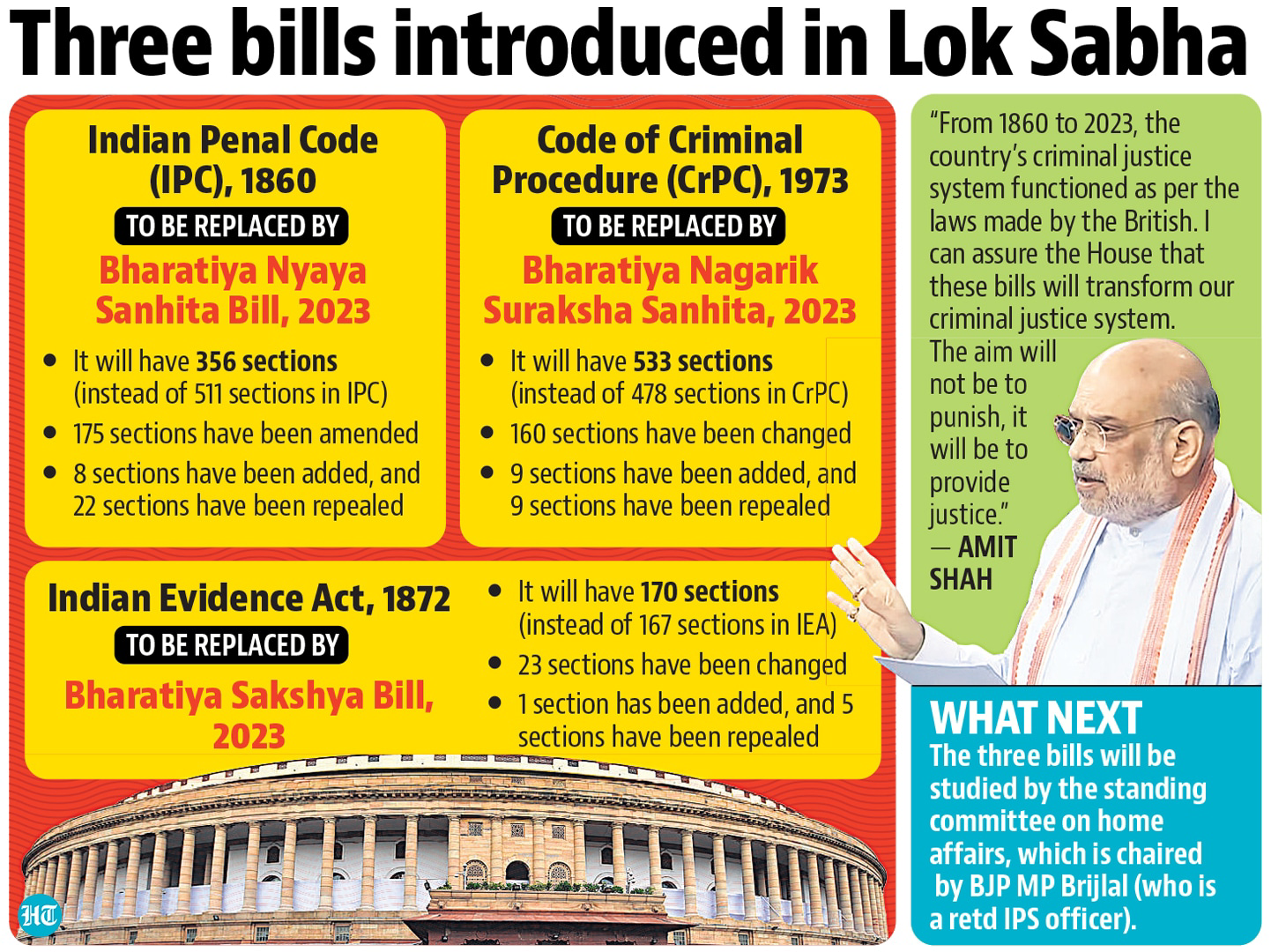
Need for new bills
- The current laws were drafted during colonial times and contain archaic language.
- Some concepts do not accurately reflect current social norms and values.
- The laws have become complex over time, leading to confusion among legal practitioners, law enforcement agencies, and the general public.
- The Parliamentary Standing Committee in its 111th and 128th reports had also highlighted the need for reforms in criminal laws.
- They lacked participation from the Indian populace and imposed foreign ideas and values.
- Changing Norms: The evolving societal perceptions. For e.g. the transition of attempted suicide from a criminal offense to a recognized mental health issue under Mental Health Care Act, 2017.
{GS2 – MoLE – Schemes} Aatmanirbhar Bharat Rozgar Yojana (ABRY)
- It was launched in 2020 to enhance job creation during COVID-19.
- It is under the administrative control of the Ministry for Labour and Employment.
- Financial assistance to employers registered with the Employees’ Provident Fund Organisation (EPFO) was provided.
- The deadline for registration of beneficiaries was 31.03.2022.
- It has surpassed its targets.
{GS2 – MoMSME – Schemes} Udyam Sakhi Portal
- It was launched in 2018.
- It is under the administrative control of the Ministry of MSME.
- It provides information on various financial schemes, policies & programmes to make women entrepreneurs self-reliant.
{GS2 – MoPNG – Initiative} Compressed Biogas Blending Obligation (CBO)
- Context (PIB): To promote the CBG in the country, the National Biofuels Coordination Committee (NBCC) approved the introduction of phase-wise mandatory blending of CBG in CNG (Transport) and PNG (Domestic) segments of the City Gas Distribution (CGD) sector.
Compressed Biogas (CBG)
- Biofuels are fuels (solid, liquid, and gaseous) that are derived from biomass/organic matter.
- As biofuels emit less CO2 than conventional fuels, they can be blended with existing fuels to reduce CO2 emissions.
- Biogas is a type of biofuel that is produced by anaerobic digestion of organic matter.

- The biogas is purified to eliminate hydrogen sulfide (H2S), carbon dioxide (CO2), and water vapour and then compressed into CBG.
- CBG has a methane (CH4) content of more than 90%.
- CBG has a calorific value and properties akin to Compressed Natural Gas (CNG).
- It can replace CNG, leveraging the abundant biomass resources in the country.
|
Compressed Natural gas (CNG) and Piped Natural gas (PNG)
- Natural gas is a fossil fuel that primarily consists of methane.
- It contains small amounts of other hydrocarbons, such as ethane, propane, butane, and pentane.
- It also contains nonhydrocarbon gases, such as carbon dioxide and water vapour.
- It burns cleaner than other fossil fuels, emitting fewer air pollutants and greenhouse gases.
- CNG is natural gas compressed to a pressure of 200-250 kg/cm2 and is used as a vehicular fuel.
- PNG is natural gas distributed through a pipeline with safety valves to maintain pressure for domestic cooking and heating/cooling applications.
Implementation of CBG Blending Obligation (CBO)
- CBG Blending Obligation (CBO) will be voluntary until FY 2024-2025 & mandatory from FY 2025-26.
- CBO will be 1% of total CNG/PNG consumption for FY 2025-26 and increase to 5% in 2028-29.
Advantages of CBG Blending Obligation (CBO)
- Circular economy: A circular economy minimises waste and pollution, prolongs resource use, and regenerates natural systems in the production and consumption model.
- Achieving net zero emission: India’s target to achieve net zero emission is 2070.
- Protecting the environment
- Saving of forex
National Biofuels Coordination Committee (NBCC)
|
Sustainable Alternative Towards Affordable Transportation (SATAT)
|
{GS2 – MoRD – Initiative} Cactus for Green Economy in Watershed Projects
- Context (PIB): Cactus has been chosen to be planted in rain-fed/degraded lands under the Watershed Development Component of Pradhan Mantri Krishi Sinchayee Yojana (WDC-PMKSY).
|
Watershed Development Component of PM Krishi Sinchayee Yojana (WDC-PMKSY)
- It is a centrally sponsored scheme implemented by the Department of Land Resources (DoLR) under the Ministry of Rural Development (MoRD).
- Objective: to develop rainfed/degraded lands in the country sustainably.
- WDC-PMKSY permits planting diverse suitable vegetation to restore rain-fed/degraded lands.
Significance of Cactus Cultivations in Watershed Areas
- Cactus is a perennial succulent, drought-resistant & multi-purpose crop.
- It is ideal for growing in dry and degraded lands.
- It has significant ecological, economic and social potential.
- Cactus cultivation holds promise for GoI’s goal of doubling farmers’ incomes and fostering economic activity and ecological conservation.
Benefits of Cactus Cultivations
- Biogas generation: Cactus can be used as feedstock for biogas generation.
- Food source: The high sugar and low acid blend of cactus pears makes them delicious and palatable.
- Fodder: Cactus cladodes are low-cost green fodder for livestock, especially in arid and semi-arid areas.
- Bio leather: Leather made from plants is non-violent and has a low environmental impact.
- Carbon sequestration
Pradhan Mantri Krishi Sinchayee Yojana (PMKSY)
|
{GS2 – MoT – Schemes} Schemes in News
- Context (PIB): Various schemes were discussed in the Parliament.
Swadesh Darshan 2.0 (SD2.0)
- It promotes the ‘vocal for local’ mantra to attain “Aatmanirbhar Bharat” in tourism.
- Benchmarks and standards for generic and theme-specific development of tourism destinations will also be developed.
- Themes: Culture and Heritage, Adventure Tourism, Eco-Tourism, Wellness Tourism, MICE Tourism, Rural Tourism, Beach Tourism, Cruises – Ocean and inland.
|
Swadesh Darshan
|
Pilgrimage Rejuvenation And Spiritual Augmentation Drive (PRASAD) scheme
- It was launched in 2014-2015.
- It is under the administrative control of the Ministry of Tourism.
- This scheme focuses on developing the religious tourism experience in India.
{GS3 – IE – Institutions} Sovereign Credit Rating Agencies (SCRAs)
- Context (TH | IE): India’s Chief Economic Advisor flagged the ‘opaque’ methodologies followed by the world’s top SCRAs.
Sovereign Credit Rating (SCR)
- SCR is an independent assessment of the creditworthiness of a country or sovereign entity.
- SCRs can tell about the level of risk associated with investing in sovereign debt instruments.
- Standard & Poor’s (S&P), Moody’s, and Fitch Ratings are the three most influential SCRAs.
- Economic growth, fiscal policies, public debt levels, political stability, and external trade position are observed to assign an appropriate credit rating.
- Importance: Better SCR can lead to cheaper governmental borrowings from the international bond market and increased FDI.
|
Government bonds/Government securities(G-Sec)/Treasury bills
|
Issues with SCRAs
- Qualitative factors in rating methodologies give rise to bandwagon effects and cognitive biases.
- It is alleged that countries’ ‘willingness to pay’ can manipulate the SCR.
- Despite slowdowns, no fall in the ratings of developed economies seems discriminatory.
- SCRAs use the World Bank’s “Worldwide Governance Indicators”, which have debatable observations.
- The stagnant BBB- rating of India, despite improvement to being 5th largest economy, is a concern.
Way Forward
- The Chief Economic Advisor of India recommended that the SCR model should include the debt repayment history of a country.
{Prelims – Envi – Species} Protection of Black Tiger
- Context (PIB): Black tigers have been recorded only in the Similipal Tiger Reserve in Odisha.
- A black tiger is a melanistic colour variant of the tiger.
- It is not a distinct species or geographic subspecies.
Simlipal Biosphere Reserve, National Park, Tiger Reserve
- Located in the Eastern Ghats, it is listed in the UNESCO World Network of Biosphere Reserves.
- It lies within two biogeographical regions:
- Mahanadian coastal region of the Oriental realm
- Chhotanagpur biotic province of the Deccan peninsular zone
- Mayurbhanj Elephant Reserve = Similipal Tiger Reserve + Hadgarh + Kuldiha Wildlife Sanctuary.
- Vegetation: Moist and dry deciduous forests and grasslands.
- Major Fauna: Bengal tigers, wild elephants, gaurs (Indian bison), chausingha.
- Major Avifauna: Hill myna and crested serpent eagle.
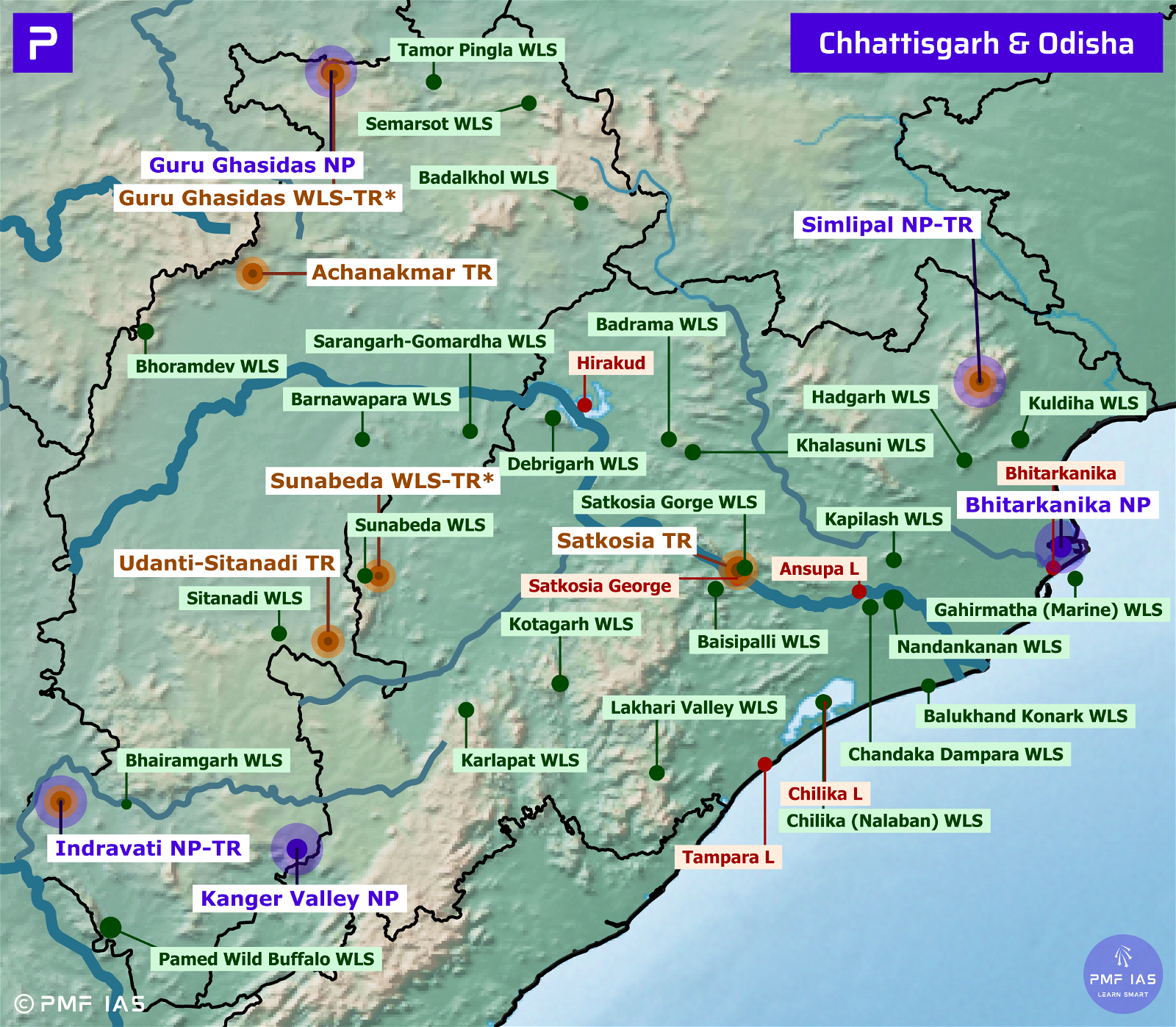
{Prelims – Species In News} Blue Sea Dragon and Blue Button
- Context (WION): Two venomous marine organisms usually found in the deep sea, blue sea dragons and blue button, were spotted at Chennai’s shoreline.
- They can cause skin irritation.
- They are brought ashore by Cyclone Michaung.
|
Blue Sea Dragons
- Sea slugs are shell-less molluscs that come in various colours and shapes.
- Blue sea dragons are a type of sea slug.
- They are often spotted in groups, creating formations known as ‘blue fleets’.
Blue Buttons
- Blue buttons get their name from their button-like shape.
- They are not a single organism, even if they appear so.
- They are a colony of small predators called hydroids.
- They are often confused with jellyfish, which are closely related to them.




![PMF IAS Environment for UPSC 2022-23 [paperback] PMF IAS [Nov 30, 2021]…](https://pmfias.b-cdn.net/wp-content/uploads/2024/04/pmfiasenvironmentforupsc2022-23paperbackpmfiasnov302021.jpg)
